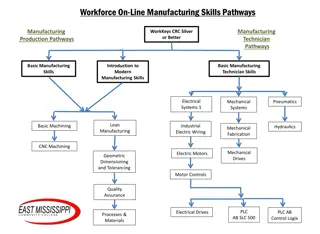Understanding Bill of Materials in Manufacturing Processes for Grades K-5
Learn about Bill of Materials (BOM) and its significance in manufacturing through accessible examples like a water bottle and a bike. Discover how BOM helps engineers ensure assembly accuracy, part tracking, and facility layout planning. Engage in making your own BOM for a bike components and understand the importance of meticulous detailing to avoid errors.
Download Presentation

Please find below an Image/Link to download the presentation.
The content on the website is provided AS IS for your information and personal use only. It may not be sold, licensed, or shared on other websites without obtaining consent from the author. Download presentation by click this link. If you encounter any issues during the download, it is possible that the publisher has removed the file from their server.
E N D
Presentation Transcript
Bill of Materials STEM and Industrial Engineering Toyota Production Systems Lab Facilities: Grades K-5
| 2 What is a Bill of Materials? A Bill of Materials is commonly used in manufacturing. They break down the bigger parts of a finished product into smaller parts (like splitting a water bottle into a bottom and a top) The top of the water bottle might have screws (like this one!) All materials are included, even the paint that you need!
| 3 How do you make a Bill of Materials? An indented Bill of Materials usually includes each item s level and name of the part. A Bill of Materials has different levels. Level 0 is the finished product (like a water bottle). Level 1 would be everything that you need to put together to make the water bottle (let s use the top as an example). Level 2 would be what you need to make the top (the screws and handle). The next slide has an example!
| 4 Water Bottle Example A Bill of Materials has its levels indented as well! Let s take a look at the water bottle from earlier and make a Bill of Materials. Level 0: Water Bottle Level 1: Bottle Cap Level 2: Screws Level 2: Plastic Handle Level 1: Bottle body Level 2: Paint
| 5 Being Careful When you make a Bill of Materials, be careful not to forget anything! If you forget one thing on there, the water bottle might not come out right. Imagine if you forgot to put paint on it! It would look something like this, and the customer wouldn t be happy.
| 6 This is an example for a 3-ring binder! Notice: Everything that everything that goes into the cover is included at level 2! Assy. stands for assembly !
| 7 Why are they so important? Engineers can make sure they aren t missing a step in the assembly process They give an idea of where machines should be placed It helps engineers track parts while they move in a facility
| 8 Let s Try Our Own! Handlebars Try making a Bill of Materials for this bike! Hand brakes Seat Water bottle holder Body Click for some hints Gear belt Tire spokes The red circle is the entire body of the bike Tires
| 9 Hint 1/3 Split the bike into different sections Click for another hint with some examples
| 10 Hint 2/3 Section Examples: handlebars, tires, body, seat Click for another hint!
| 11 Hint 3/3 Don t forget the paint! Go to the next slide for an answer
| 12 Bill of Materials Solution Example Level 0: Bicycle Level 1: Body Level 2: Black Paint Level 2: Water Bottle Holder Level 3: Black Paint Level 1: Tires Level 2: Tire Spokes Level 2: Gear Belt Level 1: Handlebars Level 2: Handbrakes Level 1: Seat
| 13 How can you use the Bill of Materials? Everyone wants to try building something every once in a while. Next time you want to build something, try making a bill of materials! It will make your project much easier, and you can buy everything you need much easier. That s because everything will be organized!
| 14 What did we learn? The Bill of Materials can be helpful in many ways! They show what materials are necessary to make a part They make sure you have everything you need Things to remember: 1. Be careful not to forget small details! 2. The completed part is always level 0!
| 15 Thank you!























